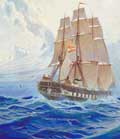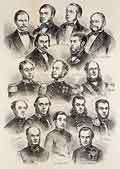| The world circumnavigation of H.M. Frigate Novara 1857–1859 |
 |
The world circumnavigation of the H.M. Frigate Novara (1857–1859) of the first Austrian endeavor of this kind and a prestigious project of the Austrian monarchy. The archduke Ferndigand Maximilian, the naval commander-in-chief, instructed captain Bernhard Freiherr von Wüllerstorf-Urbair with the actual planning of the world circumnavigation. The main objective of the expedition was to conduct fundamental research and collect data in many fields of natural science as well as to establish new business contacts.
On April, 30th 1857 the Austrian H.M. Frigate Novara set sail from Trieste. The exceptional journey lasted 551 days and took the ship to South America, Africa, India, China, and Australia (51.886 nautical miles around the globe). The crew of the 50-meter long ship consisted of 345 members and mates as well as a staff of 7 scientific researchers.
|
|
|
The mission of the Austrian-Hungarian warship was peaceful and was conducted in the search for innovation, science, and communication. Despite the outbreak of war between the French empire and Sardinia-Piedmont on the one side and the Austrian empire on the other side, the H.M. Novara was not attacked. Moreover it was given cover because of its precious mission - long before the League of Nations (UN) and the UNESCO the thought of the world cultural heritage was formulated. "... because science is common property of all peoples." (Napoleon III)
|
|
|
|
–>> top |
|
|
|
| Expedition partners: |
|
|
|
|
Imperial Academy of Sciences
|
|
|
Geographical Society
|
|
|
Geological Reichsanstalt (mineralogy and paleontology)
|
|
|
Zoological-botanical Society
|
|
|
Society of Doctors
|
|
|
Companies and traders offered their products at low prices. Some are enumerated here.
NM Rothschild & Sons
The London Bank "NM Rothschild & Sons" guaranteed a credit line of 32.000 pounds, which covered about two thirds of the 585.000 gulden needed.
Schlumberger
provided plenty of white and red wine as well as champagne "Vöslau-Goldeck"
- among other to prove that their wines were not perishable
|
|
|
|
–>> top |
|
|
|
| Innovation on board of H.M. Fregat Novara 1857–1859 |
|
H.M. Novara was not an expedition ship in the ordinary way, but a research platform for testing the newest technology.
|
|
|
Examples:
Draque - a new dragnet developed by the ichthyologist Prof. Goodsir from Edinbourgh was used for the examination of the sea bottom.
Distillation engine - M Rocher from Nantes tested the process of drinking water purification
The hygienic circumstances of the crew on board were especially trend-setting
„Melange d´Equipage“ (Most modern tinned food from Chollet)
Compressed, dried vegetables in airproof sealed tins for the crew, to prevent the spread of epidemics from imported food.
Showers a special construction for the crew sanitary facility was installed
Enamel-dishes were used for the first time and improved the hygienic conditions considerably.
Statistical data of all diseases and infections from crewmembers is gathered to then create a "medical" map for future expeditions.
|
|
|
|
–>> top |
|
|
|
| Scientific findings from H.M. Frigate Novara 1857–1859 |
 |
The Academy of Sciences in Vienna prepared the expedition, which was then headed by the geologist Ferdinand von Hochstetter and the zoologist Georg von Frauenfeld. The results of the expedition were internationally acknowledged findings. Elaborate examinations have been conducted on St. Paul Island, on the Nicobar Islands and in New Zealand (where von Hochstetter stay to finish the first cartography). Research in the field of marine science made this science internationally know. Austrian museums benefited from the collections of botanical, zoological (26.000 pieces), and ethnological material. The in-depth study of geo-magnetism contributed potentially to science. The collection of leaves from the coca-plant enabled scientist to produce pure cocaine for the first time in 160.
The results were published in a collection of 21 volumes by the Academy of Sciences in Vienna under the title "The Austrian Frigate Novara's Journey around the World" (1861–76) and in a short version under the same title (in 3 volumes and published by Karl Scherzer. The 3-volume edition, which contained many xylographies, became a bestseller. Within one year the first edition of 5.000 copies was sold out. Only Alexander von Humboldts "Cosmos" has sold more copies of a book of this kind in the german speaking countries.
|
|
|
|
–>> top |
|
Medicine, Hygiene, and Nutrition |
|
|
For the first time ever the hygienical needs of the crew have been taken care of.
Statistical data of all diseases and infections from crewmembers is gathered to then create a "medical" map for future expeditions.
Specific examinations to the back then feared death of the indigenous peoples.
|
|
|
|
–>> top |
|
Geology |
|
|
„Physical and geognostic Memories“ from Alexander von Humboldt (08/04/1857 transmitted) as a suggestion to examine the sea currents, like the Humboldt-current and some volcanos.
The first ever cartography of New Zealand was conducted by Ferdinand von Hochstetter. After the Dun Mountain, Hochstetter is known in field petrography for the term dunit. Even today the "Mount Hochstetter", "Hochstetter Dom", and "Novara Peak" in the Southern New Zealand alps are reminiscences of Hochstetters achievements.
The first ever cartography of St. Paul Island and the Nicobar Islands was conducted as well.
Measurements and global statistical documentation of geomagnetism have been conducted by Vice-admiral Wüllerstorf-Urbair and several of his cadets.
|
|
|
Zoology und Botany |
|
|
Over 200 new species of animals and plants have been discovered.
First scientific description by Ferdinand von Hochstetter of a moa-skeleton. The moa
was a up to 3 meter tall "running" bird (ratite) that became extinct in the 17th century.
|
|
|
Chemisty |
|
|
The first scientific analysis of coca leaves (Erythroxylon Coca) lead to the discovery of three chemical bases: cocaine, ecgonin, and hygrin.
|
|
|
|
–>> top |

